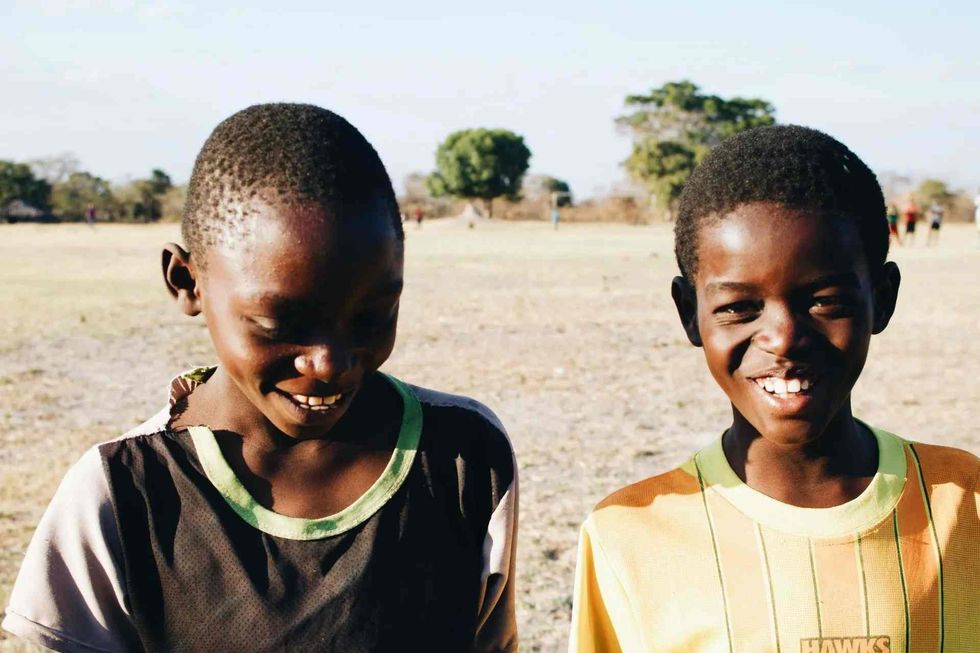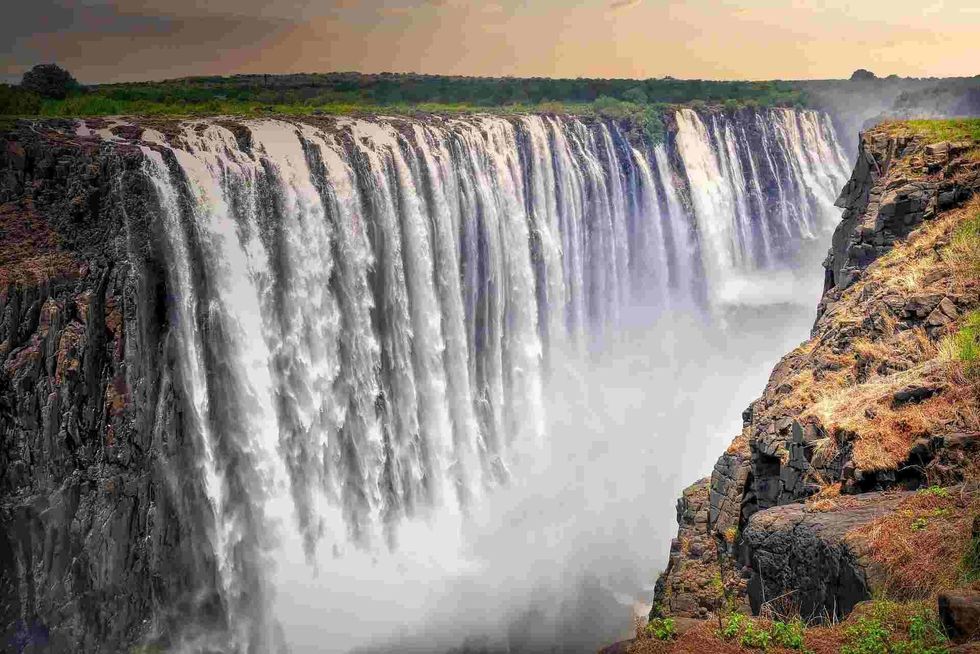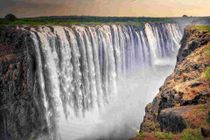Do You Know Amazing Facts About Zambia? Get To Know Below

Zambia is a land-locked country in Southern Africa, the hottest continent on this planet also known as the cradle of the human race.
Lusaka is Zambia’s capital city and Lusaka is also the name of the local language. The name of Zambia has been derived from the name Zambezi River.
Zambia is a landlocked country in Southern Africa with an abundant green background and forest cover. The tiny houses in the Mafinga hills and the tribes in the interior parts of Zambia are still living proof of the ancient lifestyle.
Victoria Falls is one of the seven natural wonders of the world found in Zambia, it was named in the honor of Queen Victoria. The country in Africa is home to grazing wild animals and different wildlife species found on the high plateau elevation.
Read on for some interesting facts about Zambia and thereafter also check fun facts about Zambia and Alfred Tennyson facts.
History
The current population of the African country Zambia is known to be living on the lands once inhabited by our ancestors for many centuries.
- The Great Rift Valley that starts from the Zambezi River in the southern region of Zambia has been believed to be the homeland for humans since ancient times.
- The Zambezi River then connects to the Nile in Egypt. The African Rift Valley has been a hotspot for excavations and historical evidence.
- Many archeologists seek information in the Rift Valley region to unlock the mysteries of civilizations three million years ago. There are some stone implements and weapons found at this site of the Zambezi River, similar to the ones found in Kenya.
- Historians believe that stone age sites of the early age have been discovered in many regions of Zambia.
- The most significant sites unearthed in Zambia are Kalambo Falls and Victoria Falls. The findings disclose an estimation that humans in the primitive era started using fire back in some 60,000 years.
- An entire complex has been discovered and unearthed that showcases the progress and development of early human skills. A skull found of the Broken Hill Man dates back to around 70,000 years and indicates the features of the human face and what humans might have looked like back in the ancient times when there were no selfies!
- The advanced development with the fair utility of tools, refined weapon use and manufacture of polished stones, differentiation within the community and different groups of people, and burial after death signified the second phase of the Stone Age.
- Early humans lived near the places of water resources and had settlements in tiny groups. They sustained and survived on the water resources, and hunting was their primary occupation. They also searched for fruits, honey, tubers from the natural forest region and surroundings.
- Interestingly, the skulls of early Stone Age Africans showed signs of tooth decay caused by excess eating of honey. They also migrated to different places as per the changing seasons.
- Early hunter-gatherers lived in caves and found shelter under rocks. They decorated the walls with paintings, which is one of the most substantial pieces of evidence of their lifestyle and cultural evolution.
- The climate of Zambia is exceptionally humid during the rainy season.
- The art and paintings belonging to these humans were more decorative. The picture did not involve any religious or ritualistic meaning.
- As years and centuries went by, the inventions and discoveries by the early humans developed. The bow and arrow were invented, which gave an impetus to the hunting game and proved to be a lasting weapon during war. They entirely depended on their hunting for survival and didn't keep any stock.
- During the 300 BC and 400 AD era, Zambia was then occupied by the Negroid race, which later spread to the entire country of Africa. The cultural resemblance and the lifestyle are also reflected in the present-day tribes of aboriginals in the African continent.
Zambia Language
Zambezi people have multiple means of communication. Ethnicity involves a wide range of dialects. Surprisingly the official language of the African country Zambezi is English. But there are around 70-80 varied languages spoken in the whole country. Along with these varieties come the different dialects the Zambezi population tells.
- The majority of the people will understand and speak basic English. The urban areas in Zambia are more fluent in speaking English.
- The official documents and signing of documents, formal administration involves using the English language. The majority of the population is handling the office work in English. Apart from that, there are two local languages popularly spoken by many groups. They are Bemba and Nyanja.
- Around two million Zambians speak in the Bemba language, and hence it is also used in education and local administration.
- Nyanja is a Bantu language that one million people speak of Zambia. It is widely used in many centers and is popular in Livingstone and Lusaka.
- Nyanja is also the official language of the police in Zambia. It is popularized in the neighboring countries of Zimbabwe, Mozambique, and Malawi too. The media publications and media houses use the language of Tonga, which is another commonly used local language.
- Around 11 % of the Zambian population speak the Tonga language. Apart from these two, there are other local and native languages spoken in Zambia.
- Other languages include the Lozi, with almost 500,000 speakers. 300,000 native speakers speak the Nsenga languages. The other principal languages spoken in Zambia are Lunda, Mashi, Tumbuka, Mbunda, Luyana, Luchazi, Mambwe-Lungu, and Nyika.

Culture
Zambia’s contemporary lifestyle and culture mix values, spiritual traditions and beliefs, norms, and rituals of more than 70 ethnic diversities. Many of the tribes in Zambia evolved with migration a few centuries ago, and hence their culture and traditions have been growing too.
- They are the fastest-growing population in the African continent and consequently traveled many places in search of new lands, new pastures, and new kingdoms.
- Before Zambia became a British Colony, it was a cluster of several independent states. Each state had an economic trade link with each other within Zambia and also outside the world. Zambian economy was mainly dependent on the exports of copper and exchange of ivory and slaves. They get in return salt, hardware, jewelry, and textiles.
- The British colonies expanded the economic growth by the rapid urbanization process and the after-effects of industrialization. This led the Zambian population to witness the exposure of western culture and the influence of western ideologies that improved their standard of life with conscious effort.
- However, many tribes and inhabitants in rural areas and the interior parts of Zambia have maintained their ethnic culture and authentic rituals and beliefs.
- Independence in 1964 recognized the role of government in ruling and realized the role of culture was to bring overall development in the country and establish a national identity among the Zambian population.
- Soon, institutions were established to protect and preserve Zambian culture’s rich values and traditions. The National Heritage Conservation Commission was created for this reason. To promote the cultural lifestyle and express the artistic talent of the ethnic tribes, private museums were founded, and the government of Zambia announced cultural villages.
- Another interesting fact about Zambian people is that they believe in animism. It is a term used to denote belief in nature and natural entities such as trees, animals, and artificial idols from stone wood.
- The ancestors had supernatural powers, which made the Zambians believe that witch doctors could prevent and cure any disease and predict an alarming event in the future. The ancestors were thought to be able to talk to humans.
- Many people in Zambia believe and practice their beliefs to date. It is part of their traditional world.
Interesting Facts About Zambia
Did you know that there are currently around 45 countries designated as landlocked countries in the world? Zambia is one of them. Here are some interesting facts about Zambia that you will certainly enjoy:
- Zambia is a country located in Africa and is a landlocked country which means it is surrounded and enclosed by land with zero access to any open water bodies or sea.
- In the year 1889, the government of Zambia was occupied and colonized by the British. Zambia’s official name is the Democratic Republic Of Zambia and shares borders with the eight African countries. Botswana, Tanzania, and Zimbabwe are among the neighboring countries of Zambia.
- During the 19th century, both Zimbabwe and Zambia were the early colonies of the British empire. A man named Cecil Rhodes successfully established control over the Zambian people, and hence it was named after that man as northern Rhodesia.
- Southern Rhodesia is the former name of Zimbabwe. Southern and Northern Rhodesia were lands north and south of the Zambezi river.
- October 24, 1964, is celebrated as Independence day in Zambia. Zambia was declared independent from British rule and no longer remained a British colony and became known as the Republic.
- With the new economic development, many people in Zambia became unemployed since companies were either sold out or downsized. Since copper started to fetch low prices in the global markets, many companies have reduced their production of copper.
- Zambia is also the world’s poorest country and has poor living conditions. Poverty has now become the crucial social issue of Zambia. It is estimated that around 60% of the Zambian population lives in poverty.
- Therefore poverty is one of the national problems in Zambia. Mafinga Central is the highest region of the Mafinga Hills, right at the central position of the border of Zambia and Malawi. It stands at an elevation of 7,718 ft (2,352.4 m) above sea level.
- Zambia is almost 3,625 mi (5,833.8 km) inland of the Indian Ocean. The country is rich in many natural wonders for tourists. The African fish eagle is the national bird of Zambia, Zimbabwe, and South Sudan.
- Zambia has around 20 National parks and reserves. It is possible to spot the big five animals, namely lion, elephant, rhino, buffalo, and leopard, at a single spot in Zambia. There are around 34 game management areas that offer protection to about 30% of the forest land area in the country.
- The many forests cover the wildlife in the natural habitat with minimum human interference. Zambia is known to have an abundance of copper reserves.
- Zambia is the second-largest copper-producing country in the African continent after the Democratic Republic of the Congo. The nation is among the top 10 copper producers in the world.
- The Zambian economy is boosted with the manufacturing of metal and exporting copper.
- The famous Victoria Falls are attributed to the country of Zambia. The Victoria Falls spans the entire width of the Zambezi River, which is more than 5,610 ft (1,709.9 m) wide. The waters of the Victoria Falls drop for a height of about 356.4 ft (108.6 m). Zambia also shares some parts of Victoria Falls with its neighbor Zimbabwe.
- The lowest point in Zambia is in the Zambezi River, at 1,085 ft (330.7 m).
- Unfortunately, in 2019, the Victoria Falls had been diminished to a mere trickle of water, indicating the worst drought happening in the region. This drought situation was never seen before at the mighty Victoria Falls.
- There is also a place to swim named the Devil’s Pool, a natural pool at the lap of Victoria Falls. It is safe to swim in any season. Devil’s Pool stands almost midway through the Victoria Falls on the Zambia side. Termite Hills in Zambia is almost as large as a small house. The pool looks dangerous at first glance, but it is an entirely safe spot.
- Lake Kariba is the largest artificial lake in Zambia that shares the southern border with Zimbabwe.
- Luangwa River is one of the major rivers of Zambia and a vital tributary of the Zambezi River.
- Khoisan people are indigenous peoples of Southern Africa. Lake Tanganyika is the second-largest freshwater lake in the world.
- Four countries share the lake: the Democratic Republic of the Congo, Zambia, Burundi, and Tanzania. There are some border tension and hydro-power plant built on the Kariba dam and Victoria Falls sharing issues between Zimbabwe, Zambia, and Congo.
Here at Kidadl, we have carefully created lots of interesting family-friendly facts for everyone to enjoy! If you liked our suggestions for facts about Zambia then why not take a look at ancient Africa facts, or African culture facts.
We Want Your Photos!
More for You
Bachelor of Commerce, Master of Business Administration specializing in Marketing

Supriya JainBachelor of Commerce, Master of Business Administration specializing in Marketing
As a skilled member of the Kidadl team, Shruti brings extensive experience and expertise in professional content writing. With a Bachelor's degree in Commerce from Punjab University and an MBA in Business Administration from IMT Nagpur, Shruti has worked in diverse roles such as sales intern, content writer, executive trainee, and business development consultant. Her exceptional writing skills cover a wide range of areas, including SOP, SEO, B2B/B2C, and academic content.
Postgraduate Diploma in Management

Sakshi RaturiPostgraduate Diploma in Management
Sakshi has experience in marketing strategy, social media planning, and recruiting industry experts for capstone projects, she has displayed a commitment to enhancing their skills and knowledge. She has won multiple awards, including a Certificate of Appreciation for Creative Writing and a Certificate of Merit for Immaculate Turut, and is always seeking new opportunities to grow and develop.
Disclaimer
1) Kidadl is independent and to make our service free to you the reader we are supported by advertising. We hope you love our recommendations for products and services! What we suggest is selected independently by the Kidadl team. If you purchase using the Buy Now button we may earn a small commission. This does not influence our choices. Prices are correct and items are available at the time the article was published but we cannot guarantee that on the time of reading. Please note that Kidadl is a participant in the Amazon Services LLC Associates Program, an affiliate advertising program designed to provide a means for sites to earn advertising fees by advertising and linking to Amazon. We also link to other websites, but are not responsible for their content.
2) At Kidadl, we strive to recommend the very best activities and events. We will always aim to give you accurate information at the date of publication - however, information does change, so it’s important you do your own research, double-check and make the decision that is right for your family. We recognise that not all activities and ideas are appropriate for all children and families or in all circumstances. Our recommended activities are based on age but these are a guide. We recommend that these ideas are used as inspiration, that ideas are undertaken with appropriate adult supervision, and that each adult uses their own discretion and knowledge of their children to consider the safety and suitability. Kidadl cannot accept liability for the execution of these ideas, and parental supervision is advised at all times, as safety is paramount. Anyone using the information provided by Kidadl does so at their own risk and we can not accept liability if things go wrong.
3) Because we are an educational resource, we have quotes and facts about a range of historical and modern figures. We do not endorse the actions of or rhetoric of all the people included in these collections, but we think they are important for growing minds to learn about under the guidance of parents or guardians.







